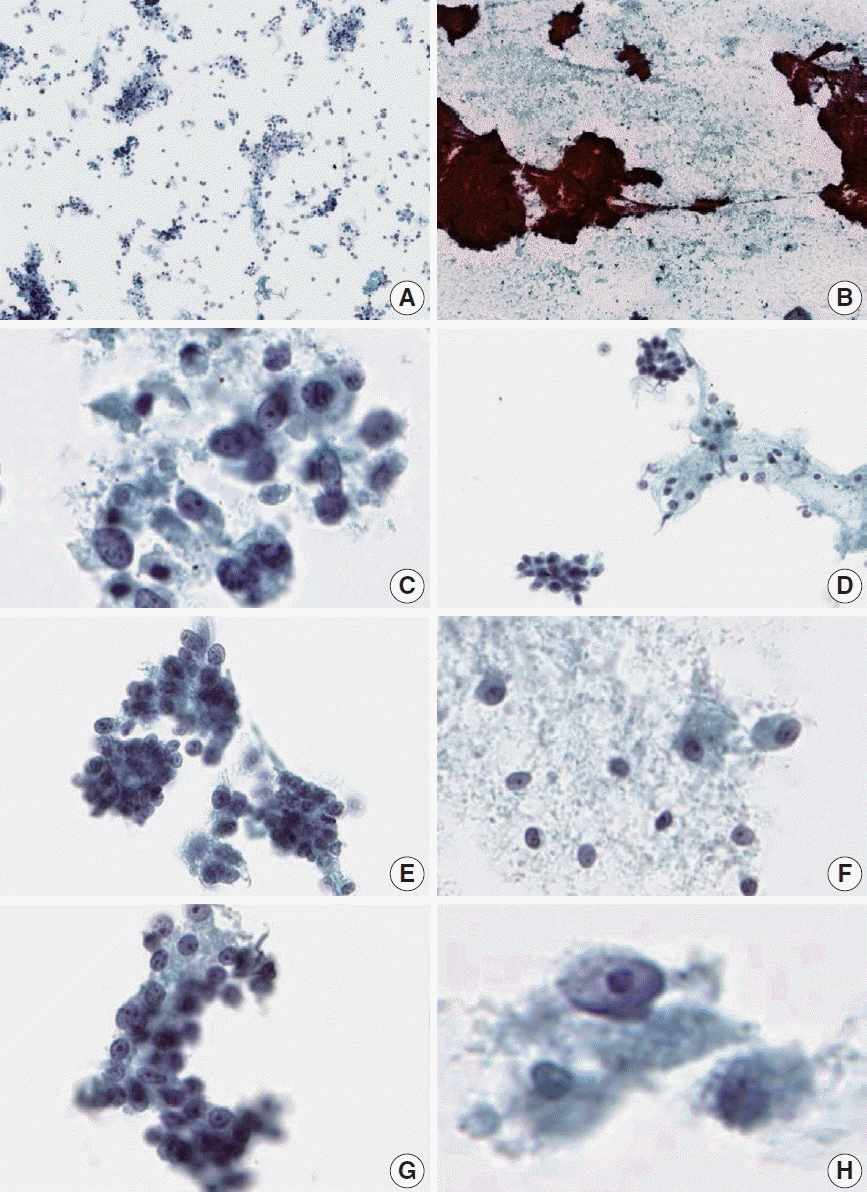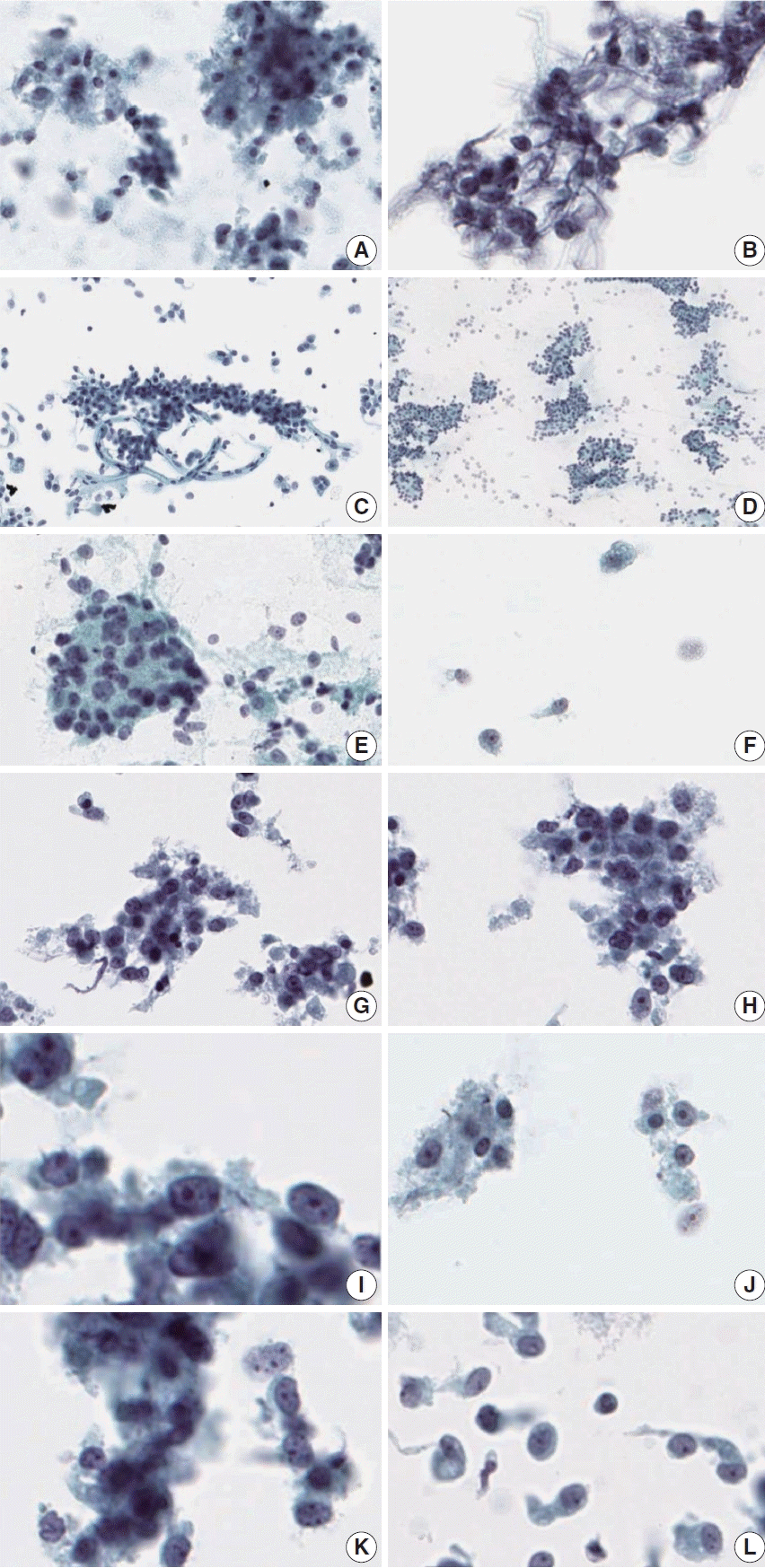1. Toll AD, Hruban RH, Ali SZ. Acinar cell carcinoma of the pancreas: clinical and cytomorphologic characteristics. Korean J Pathol. 2013; 47:93–9.
2. Holen KD, Klimstra DS, Hummer A, et al. Clinical characteristics and outcomes from an institutional series of acinar cell carcinoma of the pancreas and related tumors. J Clin Oncol. 2002; 20:4673–8.
3. Attaway CC, Yang Z, Wu RI. Diversity and pitfalls of pancreatic neuroendocrine tumors: a case series of cytologic-histologic correlation. Hum Pathol Rep. 2022; 28:300630.
4. Sigel CS, Klimstra DS. Cytomorphologic and immunophenotypical features of acinar cell neoplasms of the pancreas. Cancer Cytopathol. 2013; 121:459–70.
5. HooKim K, Reid MD. Atypical cells in fine needle aspiration biopsies of pancreas: causes, work-up, and recommendations for management. Diagn Cytopathol. 2022; 50:196–207.
6. Chun JW, Lee K, Lee SH, et al. Comparison of liquid-based cytology with conventional smear cytology for EUS-guided FNA of solid pancreatic masses: a prospective randomized noninferiority study. Gastrointest Endosc. 2020; 91:837–46.
7. Stelow EB, Bardales RH, Stanley MW. Pitfalls in endoscopic ultrasound-guided fine-needle aspiration and how to avoid them. Adv Anat Pathol. 2005; 12:62–73.
8. Siddiqui AA, Kowalski TE, Shahid H, et al. False-positive EUSguided FNA cytology for solid pancreatic lesions. Gastrointest Endosc. 2011; 74:535–40.
9. Bardales RH, Centeno B, Mallery JS, et al. Endoscopic ultrasoundguided fine-needle aspiration cytology diagnosis of solid-pseudopapillary tumor of the pancreas: a rare neoplasm of elusive origin but characteristic cytomorphologic features. Am J Clin Pathol. 2004; 121:654–62.
10. Eloubeidi MA, Jhala D, Chhieng DC, et al. Yield of endoscopic ultrasound-guided fine-needle aspiration biopsy in patients with suspected pancreatic carcinoma. Cancer. 2003; 99:285–92.
11. Ohike N, Kosmahl M, Kloppel G. Mixed acinar-endocrine carcinoma of the pancreas: a clinicopathological study and comparison with acinar-cell carcinoma. Virchows Arch. 2004; 445:231–5.
12. Kumar P, Rana SS, Kundu R, et al. Endoscopic ultrasound-guided fine-needle aspiration cytology in diagnosing intra-abdominal lesions. Cytojournal. 2022; 19:56.
13. Nasser A, Forse CL, Walsh C, Moyana T, Goel R. Mixed pancreatic acinar cell-ductal adenocarcinoma: complexities in diagnosis and treatment. Curr Probl Cancer Case Rep. 2022; 5:100144.
14. Zhou W, Gao L, Wang SM, et al. Comparison of smear cytology and liquid-based cytology in EUS-guided FNA of pancreatic lesions: experience from a large tertiary center. Gastrointest Endosc. 2020; 91:932–42.
15. Ko SH, Pyo JS, Son BK, Lee HY, Oh IW, Chung KH. Comparison between conventional smear and liquid-based preparation in endoscopic ultrasonography: fine needle aspiration cytology of pancreatic lesions. Diagnostics (Basel). 2020; 10:293.
16. Haque S, Dietz R, Perez MC. Recognizing the distinct cytomorphologic features of solid pseudopapillary neoplasm of the pancreas. J Gastrointest Oncol. 2016; 7:E13–6.
17. Wang BG, Mani H, Wang ZQ, Li W. Cytological diagnosis of pancreatic solid-pseudopapillary neoplasm: a single-institution community practice experience. Diagnostics (Basel). 2022; 12:449.
18. Klimstra DS, Adsay V. Acinar neoplasms of the pancreas: a summary of 25 years of research. Semin Diagn Pathol. 2016; 33:307–18.
19. Klimstra DS, Rosai J, Heffess CS. Mixed acinar-endocrine carcinomas of the pancreas. Am J Surg Pathol. 1994; 18:765–78.
20. Labate AM, Klimstra DL, Zakowski MF. Comparative cytologic features of pancreatic acinar cell carcinoma and islet cell tumor. Diagn Cytopathol. 1997; 16:112–6.
21. Reid MD. Cytologic Assessment of cystic/intraductal lesions of the pancreatobiliary tract. Arch Pathol Lab Med. 2022; 146:280–97.
22. Reid MD, Stallworth CR, Lewis MM, et al. Cytopathologic diagnosis of oncocytic type intraductal papillary mucinous neoplasm: criteria and clinical implications of accurate diagnosis. Cancer Cytopathol. 2016; 124:122–34.






 PDF
PDF Citation
Citation Print
Print



 XML Download
XML Download